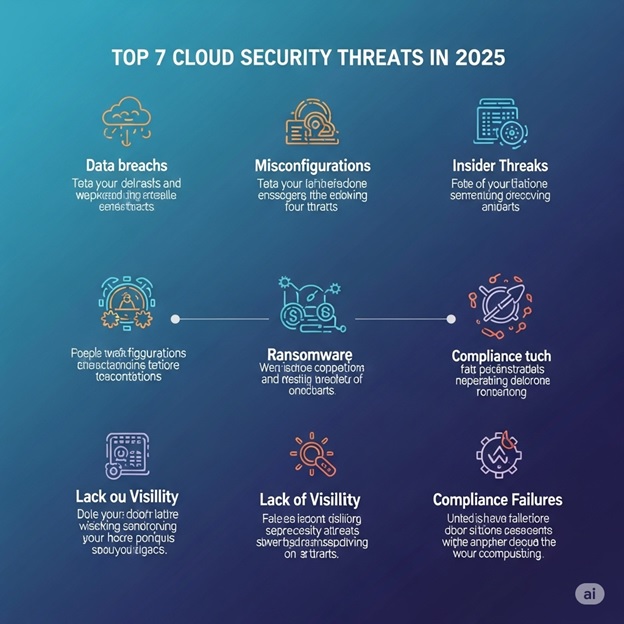Azure Information Protection keeps your business data safe in this fast-moving world where cloud threats pop up every minute, letting teams classify and label files on the fly.
In this blog by Technology Solutions Worldwide, we review the top cloud vulnerabilities of 2025 and show how Azure services, including Microsoft Defender for Cloud, strengthen cloud risk management.
These are the top 7 cloud security threats in 2025:
- Data Breaches
- Misconfigurations
- Insider Threats
- Account Hijacking
- Insecure APIs
- Ransomware Attacks
- Supply Chain Attacks
1. Compromised Credentials & Identity Exploits
Threat: 80% of cloud breaches stem from weak or stolen credentials, and password attacks remain dominant.
Mitigation with Azure:
- Enforce Multi-Factor Authentication via Azure AD.
- Keep an eye on unusual login patterns with Microsoft Defender for Cloud and Azure AD Identity Protection.
- Use Azure Information Protection to classify and guard sensitive documents linked to privileged accounts.
2. Misconfiguration & “Dangling” Cloud Services
Threat: Misconfigured DNS or storage can expose subdomains, such as the CDC breach, via dangling subdomains.
Mitigation:
- Run continuous posture checks with Microsoft Defender for Cloud’s CSPM.
- Remediate misconfigurations automatically.
- Use Azure Policy & AIP baselines to enforce secure configurations.
3. Insecure and Inadequate API Usage
Threat: Insecure APIs open doors for data leakage and injection attacks.
Mitigation:
- Protect your APIs using Azure API Management, which is integrated with Defender for Cloud.
- Continuously scan and enforce policies on incoming requests and endpoints.
4. Zero-Day Exploits & Critical CVEs
Threat: Recent vulnerabilities like Azure SSRF (CVE‑2025‑29827) scored 9.9/10.
Mitigation:
- Enable automatic patching and alerts for end‑to‑end workloads via Defender for Cloud.
- Turn on your App Service alerts and new App Service runtime protections.
5. Ransomware‑as‑a‑Service & Data Breaches
Threat: RaaS continues targeting cloud storage misconfigurations.
Mitigation:
- Use Azure Backup and Recovery.
- Encrypt using Azure Key Vault and AIP.
- Monitor thread activity and file anomalies with Defender for Cloud.
6. AI‑Powered Phishing & Prompt Injection
Threat: Generative AI is fueling advanced phishing (47% see rise).
Mitigation:
- Use Microsoft Defender for Cloud Apps to detect anomalous cloud app activity.
- Protect documents with AIP to prevent unauthorized access and ingrained malicious prompts.
7. Supply Chain Risks & Third‑Party Services
Threat: Supply chain attacks, exposed databases (e.g., DeepSeek logs), and compromised dependencies.
Mitigation:
- Enforce governance using Azure Policy and AIP for external data flows.
- Employ Defender for Cloud’s CIEM capabilities to manage entitlements, replacing Entra Permissions Management.
Why Azure Excels for Cloud Risk Management
| Feature | Benefit |
| Microsoft Defender for Cloud | CSPM + CWPP + DevSecOps solution detects misconfigurations, threats, and code issues. |
| Azure Information Protection | Classifies, labels, and protects data as it travels through cloud environments. |
| Azure Policy & Key Vault | Enforce compliance baselines and secure key management. |
| AI‑powered Security & XDR | New XDR and AI alerts accelerate detection and response capabilities. |
Final Thoughts
The top seven key cloud dangers expected in 2025, starting from stolen login details to supply chain hacks, demand a clear, broad approach to risk management. Microsoft Azure provides a complete cloud risk management strategy centered on Azure Information Protection and Defender for Cloud that delivers the intelligent, layered protection organizations need right now.
When Technology Solutions Worldwide rolls out these tools, clients can safeguard sensitive information, satisfy compliance rules, and outpace new threats, making sure their move to the cloud is both safe and resilient.
